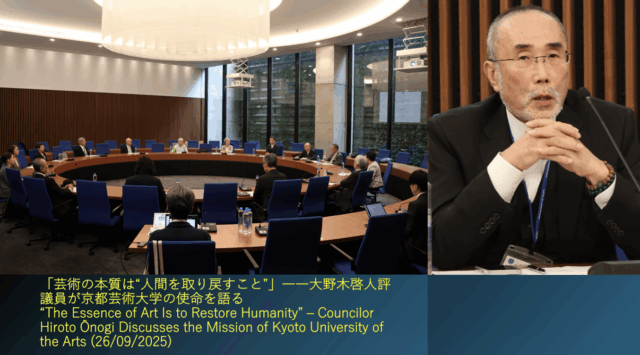
At the Council Meeting of the Kyoto International Peacebuilding Center, Mr. Hiroto Ōnogi, Council Member of the Center and Professor at Kyoto University of the Arts, spoke with conviction about the meaning of art and the mission of his university in society today.
Mr. Ōnogi began by observing that “the concept of art currently shared in society has become overly rigid,” and questioned whether Japan—while promoting itself as a “nation built on art”—has clearly defined what role art should truly play.
He emphasized that “the reason our university places art at the core of education lies in our greater purpose—to create the world anew.” However, he lamented that this purpose is still not widely understood. “The essence of art,” he explained, “lies in how we nurture individual originality and recognize each person’s dignity and human rights.”
Drawing from his experience teaching in China, particularly in Shanghai, he noted that “China’s educational system remains outdated and lacks a perspective that treats each person as an individual human being.” For that reason, Ōnogi asserted, “Our university’s existence is indispensable—to fulfill our mission of saving humanity through art.”
Looking ahead to the university’s 50th anniversary, he declared, “Whether we host a summit or issue a statement, our foundation must remain the same: to restore humanity and ensure happiness for all people.” He stressed that such goals cannot be achieved through politics or economics alone. “Within systems based on competition,” he said, “it is difficult for people to attain genuine happiness. Political slogans, in particular, sound hollow to me.”
Finally, Mr. Ōnogi called on the university to “move to the next stage” and to “become an institution recognized as a model not only in Japan but around the world.” He expressed his aspiration “to build a university that surpasses even the University of Tokyo,” concluding with a call for collective effort: “With everyone’s support, I hope we can walk this path together.” His remarks drew warm agreement from those present.
For other speakers’ statements and further details of the meeting, please click here.
(Reported by Koki IMON)
Original Speech (English Translation)
Hiroto Ōnogi
Council Member, Kyoto International Peacebuilding Center
I feel that the concept of art as it is shared in society today has become extremely rigid. Since Japan advocates itself as a “nation built on art,” I question whether we have clearly shown what role art should truly play.
The reason our university places art at the center of education is rooted in our broader goal—to create the world. Yet I feel many people do not fully understand the meaning of this mission. To put it simply, the true methodology of art lies in how we nurture individuality and recognize each person’s human rights.
As someone who actively teaches in China, especially in Shanghai, I feel that the Chinese education system remains highly traditional and lacks a perspective that treats each human being with respect. That is why I believe our university’s mission—to save humanity through art—is indispensable.
As we approach our 50th anniversary, whether we host a summit or communicate our vision to the world, our foundation must remain “to restore humanity” and “to ensure happiness for all people.” I hope we will continue to explore the methods to achieve this. It cannot be realized through politics or economics. In systems driven by competition, it is difficult for people to achieve true happiness. Political slogans, in particular, sound hollow to me.
Therefore, our university must move to the next stage—not only within Japan but as a model for the world. In Japan, we should aspire to become a university that surpasses even the University of Tokyo. With the support of everyone here, I wish to move forward together toward that goal.
